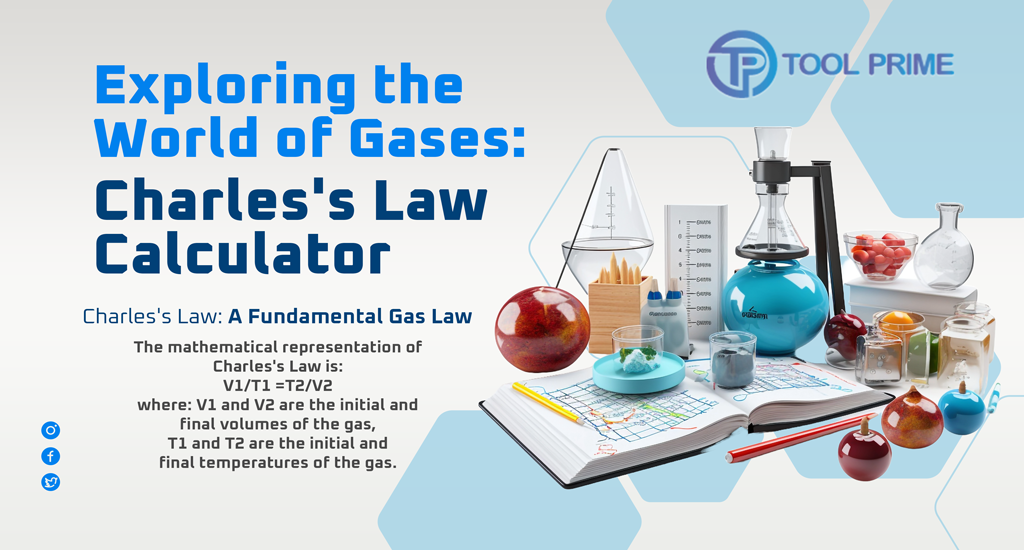Precision in Proportions: Simplifying Charles's Law with Our Calculator
 Advertisement
Advertisement
Understanding the principles of gas behavior is a crucial aspect of chemistry, and Charles's Law plays a pivotal role in this realm. As students and professionals delve into the intricacies of gas laws, precision becomes paramount. In this blog post, we will explore Charles's Law and introduce our innovative calculator tool designed to simplify complex calculations, ensuring precision in mastering this fundamental concept.
Charles's Law: A Brief Overview
Charles's Law describes the relationship between the volume and temperature of a gas at constant pressure. Simply put, it states that the volume of a gas is directly proportional to its absolute temperature when pressure is kept constant. Mathematically, Charles's Law is expressed as:
V1/T1= V2/T2
Here, V1 and T1 represent the initial volume and temperature, while V2 and T2 denote the final volume and temperature. To fully grasp this concept, one must be adept at manipulating proportions, and this is where our calculator tool steps in to make the process seamless.
Our Calculator Tool: Precision at Your Fingertips
Our calculator tool is specifically designed to simplify the calculations involved in Charles's Law, providing users with an efficient and precise solution. Let's explore the features that set our calculator apart:
1. Intuitive Interface:
The user-friendly interface of our calculator ensures that even those new to gas laws can navigate through it effortlessly. With clear input fields and concise instructions, users can focus on understanding the concepts rather than struggling with the tool.
2. Automatic Unit Conversion:
Charles's Law involves temperature, often measured in Kelvin. Our calculator automatically converts temperatures to Kelvin, eliminating the need for manual conversions. This feature not only saves time but also reduces the likelihood of errors in unit conversions.
3. Real-Time Results:
As you input the initial and final values for volume and temperature, the calculator provides real-time results. This instantaneous feedback allows users to observe the impact of changes in variables, facilitating a deeper understanding of the gas law principles.
4. Step-by-Step Solutions:
The calculator goes beyond mere results by offering step-by-step solutions. Each calculation is broken down into understandable steps, ensuring that users not only obtain the correct answer but also comprehend the underlying mathematical processes.
5. Graphical Representation:
For visual learners, our calculator tool includes a graphical representation of the proportional relationship described by Charles's Law. This visual aid enhances the learning experience, providing a holistic understanding of how volume and temperature interact.
Mastering Charles's Law: Step-by-Step Guide
Now, let's delve into a step-by-step guide on how to use our calculator tool to master Charles's Law:
Step 1: Input Initial Values
Begin by entering the initial volume (V1) and temperature (T1) into the designated fields. The calculator will automatically convert the temperature to Kelvin, streamlining the process.
Step 2: Input Final Values
Similarly, input the final volume (V2) and temperature (T2). The real-time feedback from the calculator allows you to observe how changes in these variables affect the outcome.
Step 3: View Real-Time Results
As you input the values, observe the real-time results provided by the calculator. The proportional relationship between volume and temperature is displayed instantly, giving you a visual representation of Charles's Law in action.
Step 4: Explore Step-by-Step Solutions
For a comprehensive understanding, explore the step-by-step solutions offered by the calculator. Each calculation is explained in detail, breaking down the process into manageable steps. This ensures that users not only obtain the correct answer but also comprehend the logic behind it.
Step 5: Analyze Graphical Representation
Take advantage of the graphical representation feature to visualize the relationship between volume and temperature. This visual aid enhances your understanding of the proportional nature described by Charles's Law.
Step 6: Experiment and Learn
To reinforce your understanding, use the calculator tool to experiment with different initial and final values. Adjust the temperature and volume parameters to witness how they influence each other, solidifying your grasp of Charles's Law.
Conclusion: Precision and Proficiency
Mastering Charles's Law is a fundamental step in a student's journey through the principles of gas behavior. Our calculator tool empowers users to navigate through complex calculations with precision and efficiency. From automatic unit conversion to real-time results and step-by-step solutions, the tool is a valuable companion in the quest for proficiency in gas laws. Embrace precision in proportions – simplify Charles's Law with our calculator tool, and elevate your understanding of gas behavior in the process.